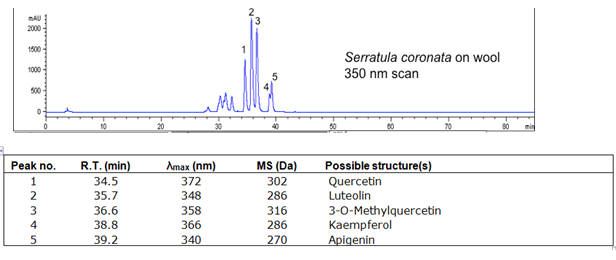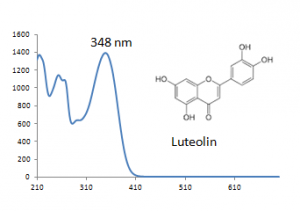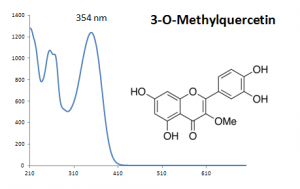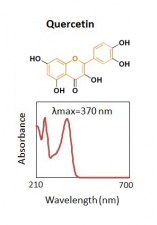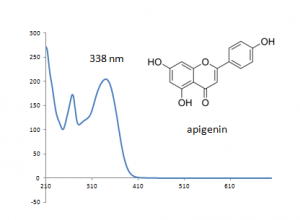Difference between revisions of "Sawwort (Serratula coronata) LC"
| (9 intermediate revisions by 2 users not shown) | |||
| Line 3: | Line 3: | ||
== Description == | == Description == | ||
| + | ''Serratula coronata'' is a perennial growing to 1.5 m (5ft). It prefers moist soil and cannot grow in the shade. It is native to the Eastern Asia and Russia. | ||
== Historical importance == | == Historical importance == | ||
| − | = Summary of results = | + | == Summary of results == |
| + | Multiple flavonids, including quercetin, luteolin, and their derivatives, were found on the wool samples from Uzbekistan. | ||
| + | == Analytical instrumentation and procedures == | ||
| − | + | HPLC-DAD-MS analysis was performed with an Agilent 1100 liquid chromatography system consisting of an automatic injector, a gradient pump, a HP series 1100 DAD, and an Agilent series 1100 VL on-line atmospheric pressure ionization electrospray ionization mass spectrometer. Separations were done on a Vydac 214TP52 analytical column (2.1 mm diameterX250 mm; 5-ím particle size). The column was eluted at a flow rate of 0.2 mL/min with a tertiary gradient of water (A),acetonitrile (B), and 1% (v/v) aqueous formic acid (C) with the following elution program: 0 min, 90% A, 5% B, 5% C; 0-55 min, a linear gradient to 35% A, 60% B, 5% C; 55-60 min, a linear gradient elution to 15% A, 80% B, 5% C; 60-62 min, isocratic elution at 15% A, 80% B, 5% C; 62-70 min gradient elution to 90% A, 5% B, 5% C; and reequilibration with the latter solvent for 15 min. The mass spectrometer was run both in the negative and positive ion mode. | |
| − | + | == Chromatograms == | |
| − | = Chromatograms = | ||
| Line 21: | Line 23: | ||
| − | Sample information | + | == Sample information == |
[[File:Sawwort 1 info.PNG|center|frame|sample information, By R. A. Laursen, Boston University ]] | [[File:Sawwort 1 info.PNG|center|frame|sample information, By R. A. Laursen, Boston University ]] | ||
| − | = Identified compounds = | + | == Identified compounds == |
| − | [[[SliderGallery rightalign|~HPLC-DAD|Luteolin.JPG~ | + | [[[SliderGallery rightalign|~HPLC-DAD|Luteolin.PNG~ Luteolin UV-Vis|3-o-methylquercetin.PNG~ 3-O-Methylquercetin UV-Vis|QuercetinUV.JPG~Quercetin UV-Vis| Kae.jpg~Kaempferol UV-Vis|Apigenin.PNG~ Apigenin UV-Vis]]] |
{| class="wikitable" | {| class="wikitable" | ||
| Line 75: | Line 77: | ||
| − | [[Category:Analysis | + | [[Category:Dye Analysis]] |
| + | [[Category:Reference Materials]] | ||
| + | [[Category:Natural Dyes]] | ||
Latest revision as of 09:23, 29 September 2017
[[File:|thumb|Yellow Botanic Gardens]]
Description
Serratula coronata is a perennial growing to 1.5 m (5ft). It prefers moist soil and cannot grow in the shade. It is native to the Eastern Asia and Russia.
Historical importance
Summary of results
Multiple flavonids, including quercetin, luteolin, and their derivatives, were found on the wool samples from Uzbekistan.
Analytical instrumentation and procedures
HPLC-DAD-MS analysis was performed with an Agilent 1100 liquid chromatography system consisting of an automatic injector, a gradient pump, a HP series 1100 DAD, and an Agilent series 1100 VL on-line atmospheric pressure ionization electrospray ionization mass spectrometer. Separations were done on a Vydac 214TP52 analytical column (2.1 mm diameterX250 mm; 5-ím particle size). The column was eluted at a flow rate of 0.2 mL/min with a tertiary gradient of water (A),acetonitrile (B), and 1% (v/v) aqueous formic acid (C) with the following elution program: 0 min, 90% A, 5% B, 5% C; 0-55 min, a linear gradient to 35% A, 60% B, 5% C; 55-60 min, a linear gradient elution to 15% A, 80% B, 5% C; 60-62 min, isocratic elution at 15% A, 80% B, 5% C; 62-70 min gradient elution to 90% A, 5% B, 5% C; and reequilibration with the latter solvent for 15 min. The mass spectrometer was run both in the negative and positive ion mode.
Chromatograms
Sample information
Identified compounds
| Compound | RT (min.) | MW | UV/vis | Other |
|---|---|---|---|---|
| Quercetin | 34.5 | 302 | 372 | Comments here |
| Luteolin | 35.7 | 286 | 348 | |
| 3-O-Methylquercetin | 36.6 | 316 | 358 | |
| Kaempferol | 38.8 | 286 | 366 | |
| Apigenin | 39.2 | 270 | 338 |
References
[1] [2] [3]
